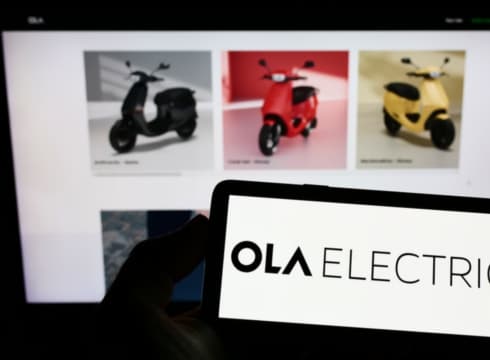In 2023 and 2024, Ola Electric would launch mass market scooter and motorcycle, and multiple premium motorcycles, Aggarwal said in a blog post
Aggarwal claimed that Ola Electric has sold 1.5 Lakh EVs in 2022, and has become the largest EV company in India by revenue and volume
The CEO also reiterated that the EV startup will launch its first electric car in 2024
Inc42 Daily Brief
Stay Ahead With Daily News & Analysis on India’s Tech & Startup Economy
Ola Electric plans to launch multiple electric two-wheeler products, including premium motorcycles, over the next 2 years, its CEO Bhavish Aggarwal said in a blog post.
The electric vehicle (EV) startup currently offers three electric scooter models – Ola S1, Ola S1 Pro, and Ola S1 Air.
“In 2023 and 2024, we will launch many more 2W EV products – a mass market scooter, a mass market motorcycle, and multiple premium motorcycles (sports, cruisers, adventure and road bikes),” Aggarwal said in the blog post.
Besides, the startup will also launch its electric cars in 2024, Aggarwal reiterated. Ola Electric had announced its plans to build electric cars in August this year.
“Our first car will launch in 2024 and by 2027 we will have 6 different products in the market,” the CEO said, adding that the scale of its two-wheeler manufacturing will enable it to make four-wheeler products at “very competitive price points”.
It is pertinent to note that Ola Electric is currently leading the race in terms of electric two-wheeler sales in India. Till date, the startup has recorded registration of over 1 Lakh EVs this year, as per Vahan data.
While Ola Electric’s vehicle sales dropped in the middle of 2022, the curve took a sharp turn after the startup launched a more affordable variant of its S1 Pro scooter and started opening experience centres in different regions of the country.
Pointing out the rise in total EV sales in India from just 4K units a month in June this year to a monthly run rate of 80K units by the end of 2022, Aggarwal said that 2022 will be remembered as the year when EV revolution truly took off in the country.
“From less than 1% penetration in 2021, to almost 6% in just a year, the EV revolution in India has not been just restricted to the urban centres, but is proving to be a pan-India phenomenon! In fact, many cities like Bengaluru, Pune, Surat, etc., already have an EV penetration of almost 20%,” the blog post said.
As per Aggarwal, Ola Electric has become the largest EV company in India by revenue and volume in just 15 months. He claimed that the startup has sold almost 1.5 Lakh EVs this year.
However, he also noted that the achievements of the EV ecosystem in 2022 are just the beginning and a much bigger opportunity lies ahead, particularly by leveraging the need and demand for budget-friendly EVs.
While the global EV transformation started in the western countries with the likes of Tesla and Rivian, who have focused on products like luxury sedans, large pickup trucks, and other formats relevant to the western audience, a majority of the world is not looking for luxury products when it comes to mobility, he said
In countries like India, over 99% of products sold are priced between INR 1 Lakh and INR 50 Lakh, and the case is the same in theSouth East Asia, Latin Amercia, Africa, and to a large extent in geographies like Europe and Japan, Aggarwal said. This price point encompasses product segments from two-wheeler including scooters, motorbikes, and small to mid-sized SUVs and cars.
“Today it is India’s destiny and opportunity to build world class products in these segments and become a global leader. Our strengths of being one of the largest and fastest growing domestic markets, entrepreneurial and innovative companies, strong government and policy momentum, world class talent and capital access will enable a strong play,” Aggarwal added.
Besides, commenting on the talks around the Indian EV industry’s heavy dependence on China for lithium, he said that while China currently dominates the midstream processing of lithium, it doesn’t control a vast majority of the mines.
Hence, India can build an alternate supply chain for itself and the world by focusing on localising the midstream processing of lithium and partnering with these countries that have mines, he said.
It must be noted that the usage of Chinese lithium-ion cells in EV batteries and other components manufactured in China also sparked a lot of debate in India this year, especially after multiple fire incidents with EVs.
After these incidents, the government tightened the regulations for EV manufacturers in India. It also barred a few companies from getting benefits under the Faster Adoption and Manufacturing of Hybrid and Electric Vehicles (FAME-II) scheme for violating localisation norms.
The year 2022 has seen a sharp rise in sales of EVs in the country. As per Vahan data, 9.8 Lakh EVs have been registered in the country, across segments, in 2022 so far as against 3.2 Lakh units last year. Two-wheeler EVs have been in the highest demand, with 6.1 Lakh units registered in 2022 so far as compared to 1.5 Lakh units last year.
{{#name}}{{name}}{{/name}}{{^name}}-{{/name}}
{{#description}}{{description}}...{{/description}}{{^description}}-{{/description}}
Note: We at Inc42 take our ethics very seriously. More information about it can be found here.


